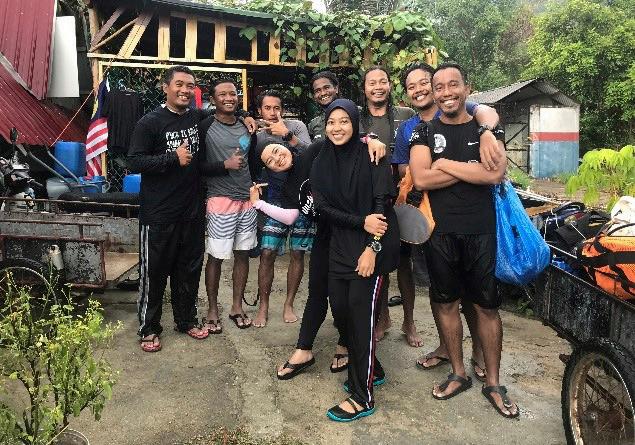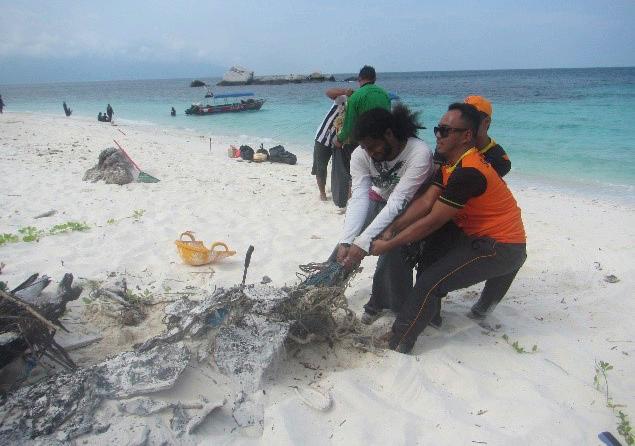
6 minute read
Reef Check
AUSTRALIA'S NORTH QUEENSLAND SHOWING SIGNS OF CONTINUED REEF HEALTH
BY REEF CHECK AUSTRALIA

The Reef Check Australia (RCA) team recently headed to Fitzroy Island to complete a reef health survey at one of the sites on the northwestern side of the island. The site has been surveyed three times over the past 13 months and continues to show strong signs of continued health. Hard coral cover has increased from 31% to 49% in that time, highlighting reef growth since substantial declines were recorded after the 2017 bleaching. Bleaching this year was evident, but most of the coral the team saw during our survey was healthy. Where bleaching was still evident, the corals were in recovery and looked like they will continue that way throughout 2020. Other notable observations included low levels of algal growth and no recently dead coral. The team was also lucky to spot a turtle relaxing amongst the corals toward the end of their survey.
Furthermore, Low Isles in the Port Douglas region of the Great Barrier Reef is truly spectacular. On a cool winters day in the shadow of COVID-19 the scene was quiet, however the reefs are looking spectacular demonstrating strong recovery from the bleaching that severely affected it three years ago. There were minimal signs of bleaching impacts in 2020 however. Thank you to Wavelength Reef Cruises for hosting RCA out on the reef and assisting them in completing their work.
INVASIVE ALGAE SARGASSUM HORNERI FOUND IN MONTEREY

During a dive along the Breakwater in Monterey, California in early June, Melanie Moreno, a Reef Check volunteer diver, observed what she suspected might be the invasive species, Sargassum horneri.
Sargassum horneri has been nicknamed “devil weed” as it has the ability to take over ecosystems and supplant lush kelp forests with bushy fields. It is native to Japan, Korea and China, and most likely arrived on a commercial vessel coming from Japan. It was first identified in California in Long Beach Harbor in 2003 and has since spread from the Northern Channel Islands to Guadalupe Island, Mexico. If Melanie’s observation was correct, it would be the first sighting north of Point Conception. Concerned that her find might represent the beginning of an invasion of this problematic species, she sent a photo of it to Reef Check to confirm the identification of the specimen. Reef Check staff confirmed the observation and immediately planned a dive to locate the specimen and look for others.
After several dives searching the site for the plant came up empty, Reef Check divers, Dan Abbott and Maxwell Seale, stumbled upon it while practicing fish transects. It measured 12 cm (5 in) in diameter, meaning it was juvenile and had not yet reached a reproductive stage. The dive team did an extensive search of the area but only found this single plant. Photos and GPS coordinates were taken and the California Department of Fish and Wildlife was immediately notified. Since this site is located within the Ed Ricketts State Marine Conservation Area, a scientific permit is required for the removal of most species, including invasives. As news of this observation spread quickly in the local research and management community, calls for the removal of this specimen were made.
A dive team from the California Department of Fish and Wildlife coordinated with Reef Check to search the site and remove the plant if found. Not only did they do so, but they found a second plant which they were able to remove. Removal of these new invaders before they have a chance to reach a reproductive state is key to protecting Monterey’s productive kelp forest ecosystems, and none of it would have occurred without the watchful eyes of a Reef Check volunteer.
When asked for permission to credit the photos and her observation, Melanie said, “Please just credit a ‘Reef Check volunteer diver’. If I hadn’t been trained and required to recertify for Reef Check every year I would not have been as focused on looking for invasive seaweeds. Not everyone who is trained goes on to complete Reef Check surveys, but the education provided puts hundreds of eyes out in the water to watch what’s going on in our marine environment.”
Reef Check California volunteers continue to look for new and potentially invasive species whether during a Reef Check survey or while diving recreationally. If you notice anything unusual during a dive, please contact your Reef Check California regional manager. Together, we can help protect these incredibly important Kelp Forest Ecosystems.
MALAYSIA’S TIOMAN MARINE CONSERVATION GROUP A SUCCESS STORY BY REEF CHECK MALAYSIA
BY REEF CHECK MALAYSIA

Research by Reef Check Malaysia (RCM) revealed that a vast majority of villagers on Tioman Island were interested in working for the Department of Marine Parks Malaysia (DMPM), the authority in charge of Marine Protected Areas in Malaysia. However, due to government hiring regulations, the islanders did not qualify to work within the DMPM. To address this issue, RCM formed the Tioman Marine Conservation Group (TMCG) in 2015. The TMCG would provide locals the opportunity to work alongside DMPM staff through a system of subcontracts, allowing them to gain valuable experience and play an important role in reducing local threats to marine life and managing the Island’s Marine Park.

Now, five years later, the Tioman Marine Conservation Group has a team of 25 villagers, all of whom are active in tourism and community service and new members are recruited on an ongoing basis. Team members have taken on numerous tasks and have made many valuable contributions to the protection and conservation of their local marine environment while working with Reef Check Malaysia, local tourism and dive operators and the DMPM, all along balancing this important work with their full-time day jobs.
Some of their most notable achievements are the installation of mooring buoys in collaboration with the Tioman Dive Association to protect the reefs from anchor damage. They are responsible for the monitoring and maintenance of reef rehabilitation projects in several locations around the island and conduct annual Reef Check monitoring surveys at 20 locations around Tioman to evaluate the health of their local reefs. Some TMCG members even helped to train others as Reef Check EcoDivers to increase the impact their work has on protecting Tioman’s reefs. This was particularly evident when this group played a vital role in monitoring the bleaching of corals around Tioman during the 2016 Global Bleaching crisis and when they monitored and helped contain Crown of Thorns sea star outbreaks to protect their reefs.

In addition to these ongoing activities, TMCG members have been called to respond to major oil spills, dead or injured marine wildlife sightings, illegal activities within the protected area, for the removal of ghost nets from reefs and they have even helped in the search for people missing at sea. Furthermore, they also train snorkel guides and consult with tour operators on sustainability and reef protection.

Over its five years of existence, the TMCG has had a real success involving the local community in co-managing marine resources. It has demonstrated how the local community can rise to the challenge of protecting its natural resources and participate in their management. It only takes a small budget, some basic training and support, but most of all it takes the willingness of all involved to work together. Reef Check Malaysia hopes to replicate this success and work with other communities to better their livelihoods by increasing reef conservation through co-management.










